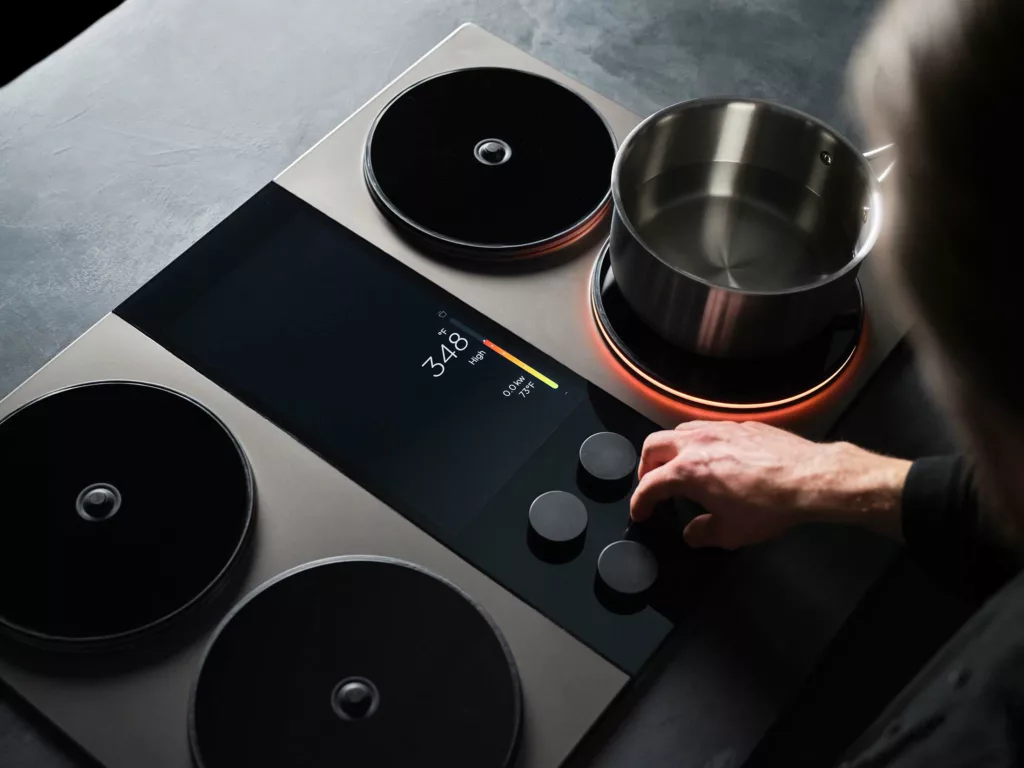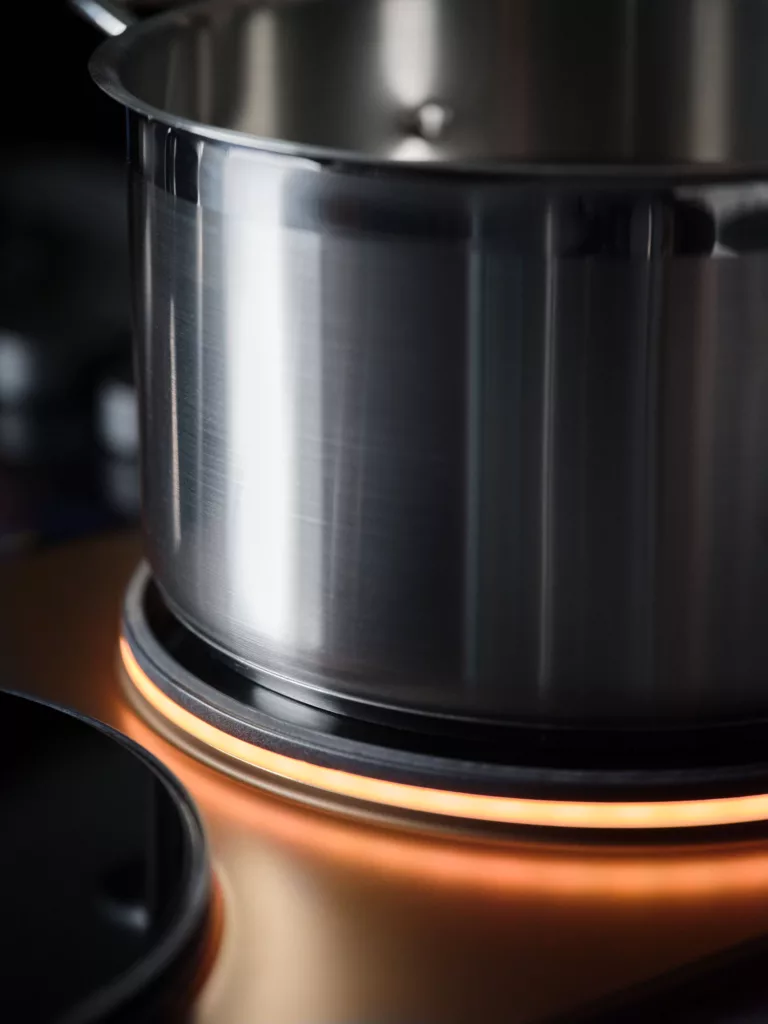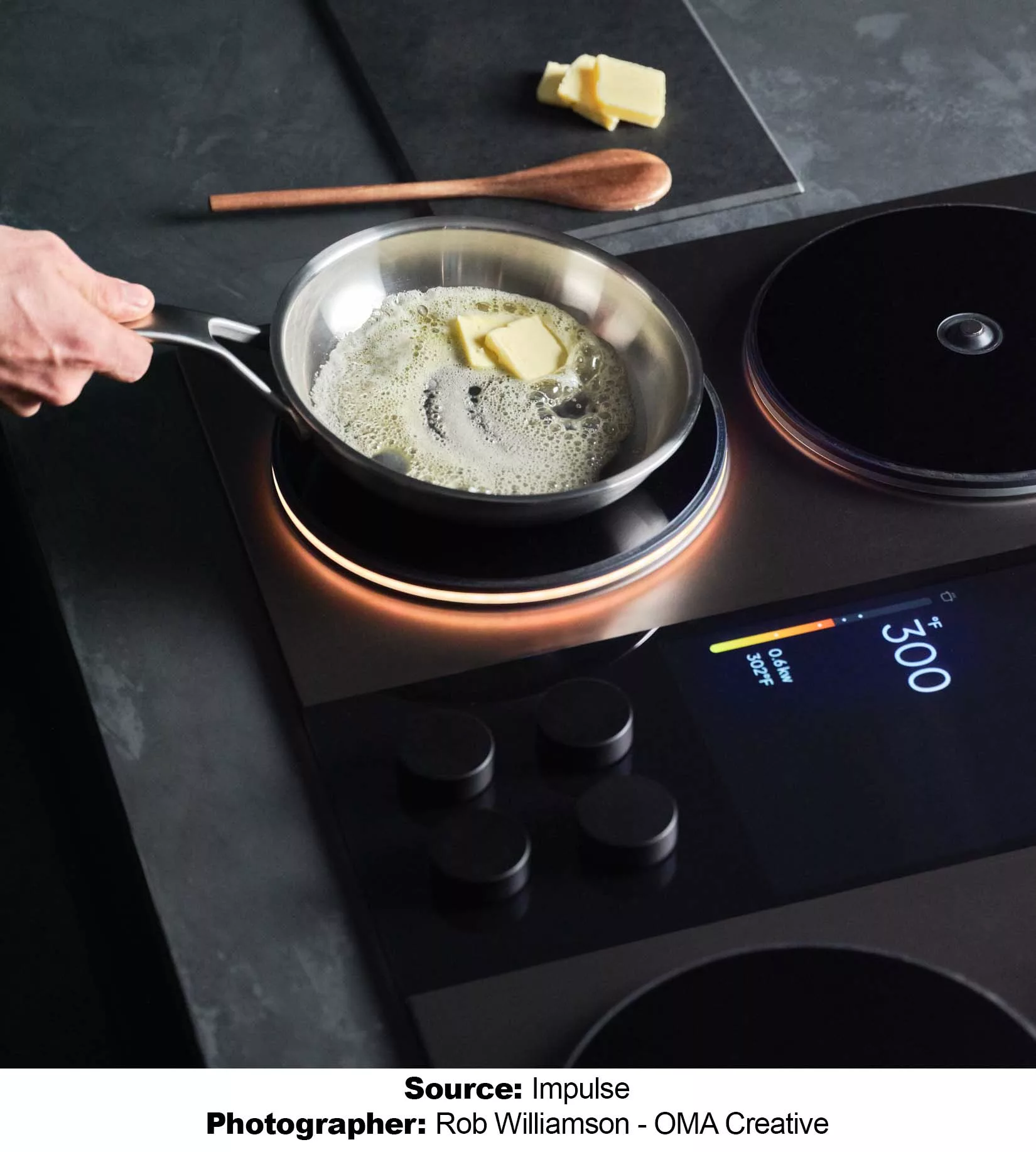Impulse Labs Induction Cooktop: Precision and Innovation
Last week, the Consumer Electronics Show (CES) in Las Vegas showcased a new induction cooktop that has me wondering if a revolution in home cooking technology is on the horizon.
What caught my attention was the Impulse Labs induction cooktop, stealing the spotlight at CES and set to hit the market by the end of the year. It’s not just another kitchen gadget; it’s packed full of new technology that both serious home cooks and environmentally conscious consumers will appreciate.
Breaking Boundaries: Adaptable Technology for Every Kitchen
What immediately grabbed my attention with the new induction cooktop is its incorporation of four temperature sensors placed in the centre of each of the 9″ induction coils.
This feature brought to mind my favorite kitchen companion, the Breville Commercial Control Freak (you can read my in-depth review of the Control Freak here). A piece of kitchen technology that I love so much that I own not one, but two of them.
The Control Freak boasts a through-the-glass temperature sensor that measures the temperature at the base of your cookware. Its algorithm then ensures a consistent set temperature, changing the way I approach cooking—particularly when delicacy is required for sauces or confidence in searing.
However, every hero has its Achilles’ heel, and for the Control Freak, it’s the seemingly simple task of boiling water. While it excels at almost every other cooking task, boiling water places the most energy-intensive demand on a cooktop. The Control Freak, operating at 120 Volts, struggles to boil large quantities of water over a sustained amount of time.
Enter the Impulse Labs induction cooktop, a culinary powerhouse that not only plugs into a more powerful 240V circuit but also easily adapts to the standard 120V/15A outlet found in practically every home. This versatility is a game-changer, especially for homeowners in older homes reluctant to splurge on electrical upgrades.
Now, you might be raising an eyebrow, wondering if connecting it to a standard 120V/15A outlet would pose similar limitations to the Control Freak. Fear not, because the Impulse Labs induction cooktop harbors a secret weapon: a 3 kWh battery! This hidden gem adds a whole new layer of powerful capability that is not found in existing high-end induction or gas cooktops.

Photographer: Rob Williamson - OMA Creative
A Power Play: Advantage of a Battery in a Cooktop
I’ll confess, initially, the concept of a battery in a cooktop didn’t really capture my attention. My primary focus was on upgrading to a high-powered precision induction cooktop to replace my trusty but underpowered Control Freak.
The perks of plugging it into a 120V/15A connection didn’t really register with me either, given that I already had a 240V connection.
However, the more I delved into the details, the more intrigued I became.
This battery isn’t just a simple feature; it’s a powerful addition to a cooktop that allows you to overcome the limitations of your home’s circuitry. Even when plugged into a 240V connection, the battery allows you to access more power than before
Consider this: my current full-sized Kenmore induction stovetop maxes out at 4100 watts of power when using the largest 10″ burner on PowerBoost. Now, with an even more powerful boost from the battery, the Impulse Labs induction cooktop can pull a staggering 10,000 watts (10kW) of power! That’s 2.44 times the power (and a whopping 5 times more than high-end gas stoves according to Impulse Labs). What does this translate to? Lightning-fast water boiling on the Impulse Labs cooktop. And once it’s boiling, you can easily dial it down to a more reasonable power level so that the battery can recharge.
Back in the lab after #CES2024 … preview of what peak performance (10kW) looks like vs. a gas stove (2.1-2.2ish kW equivalent) @ImpulseLabs_
— Sam D'Amico (@sdamico) January 13, 2024
Note the water is already hot (at 10kW it goes from faucet temperature to boiling in <40 seconds) pic.twitter.com/et39VG9vhc
As an added bonus, the battery serves as a reliable backup during power outages, ensuring your meal plans stay on track. According to Impulse Labs, this induction stove can cook up to three full meals on a full charge. But that’s not all; the battery opens the door to load shifting, offering potential savings on your bills and promoting the use of clean energy.
Powering the Impulse Labs induction cooktop is a Lithium Iron Phosphate (LFP) battery, a choice that, according to Impulse Labs, boasts “significantly improved safety and longevity characteristics compared to other Lithium battery types, commonly referred to as ‘Lithium-ion’ batteries.” The batteries are designed not only to outlast the lifespan of the appliance but also to be modular, ensuring easy replacement if the need arises.
Bidirectional Inverter: The Impulse Labs Cooktop as a Backup Power Hub for your Home
Digging into the details of the Impulse Labs induction cooktop revealed an interesting feature that I hadn’t envisioned for cooktops before: being a source of backup power for your home.
The Impulse Labs induction cooktop boasts a bidirectional inverter, a tech gem that facilitates a connection between your stove’s battery and the grid or the rest of your home by converting electricity from DC to AC.
This inverter isn’t just a technical component; it aligns with Impulse Labs’ “long term vision of incrementally building an enormous global, decentralized battery as individual appliances get upgraded.”
“When connected over a 240V hardwired connection and contingent on local regulations and utility policies, batteries can share energy with the rest of the home and help reduce peak demand from the grid,” according to Impulse Labs.
This could be an alternative to a Tesla Powerwall but more hidden and scattered throughout the home. Think about appliances like washers, dryers, hot water tanks—each becoming a silent contributor to energy efficiency, drawing power when needed but otherwise blending seamlessly into your daily life.
During my research on this product, I stumbled upon the term “Virtual Power Plants (VPP),” a concept that I think is akin to cloud computing but for the energy grid. The same concept that revolutionized computer networks could be used to fundamentally change our energy infrastructure.

Photographer: Rob Williamson - OMA Creative
Exploring Alternatives: Precision and Battery Power
While the Impulse Labs induction cooktop holds great promise, it’s worth noting that it hasn’t hit the market yet, and consumer reviews are not yet available. I’m eager to get my hands on a unit once it becomes available in Canada for a thorough review, but that may take some time.
For those with a primary focus on cooking with precise temperature control, my top recommendation is the Breville Commercial Control Freak. Mine have been kitchen stalwarts for over 5.5 years, serving me daily. I often joke that if my house were to catch fire, the first thing I’d grab is one of my Control Freaks!
In the realm of full-sized induction units offering Control Freak-level precision, options are currently somewhat limited. GE has a Café induction range with a precision cooktop sensor on one of its medium-sized burners, resembling the Control Freak sensor. However, I haven’t had the chance to personally test this model, so I can’t speak directly about its performance
When it comes to induction cooktops with built-in batteries, current offerings are scarce. However, Channing Street Copper is generating buzz and is expected to ship their first models soon (pre-sale is currently sold out). While the Channing Street Copper is a full-sized range with an integrated oven, it lacks the precision temperature sensors found in the Impulse Labs cooktop. Additionally, details about whether or not it has a diverter are unavailable, but Channing Street Copper’s website suggests the capability to plug other devices directly into the stovetop during a power outage.
Final Thoughts: The Impact of Impulse Labs Cooktop
I’m eagerly anticipating the opportunity to get my hands on an Impulse Labs induction cooktop so that I can do a proper review of it and see if it lives up to the hype. The cooktop looks very promising, and I’m hopeful it will deliver on all fronts.
The unique design sets it apart from other induction cooktops, featuring raised cooking areas that seem to simplify centering the pan on the coil for optimal heat distribution. While the absence of a 10-inch burner is a minor drawback, all the burners are 9-inches, completely bypassing inconvenient smaller burners that are common on stovetops but rarely get used.
The large LCD screen in the center of the cooktop has a lot of potential. In Impulse Labs’ product videos, the LCD screen displays only temperature and power readouts. However, I envision it maybe one day displaying timers, recipes, and other valuable information. It is unclear whether or not the firmware is updatable, but that would be a huge plus for unlocking future possibilities for this cooktop.
The Impulse Labs induction cooktop seamlessly fits into standard 30″ drop-in cutouts, which should ensure compatibility with many existing kitchen setups.
The precision combined with its possibilities for a renewable energy future has me excited not only for the cooktop but also future products from Impulse Labs. This is a company I’ll be watching closely as I think they have the potential to be a huge disruptor in the industry!

Photographer: Rob Williamson - OMA Creative

